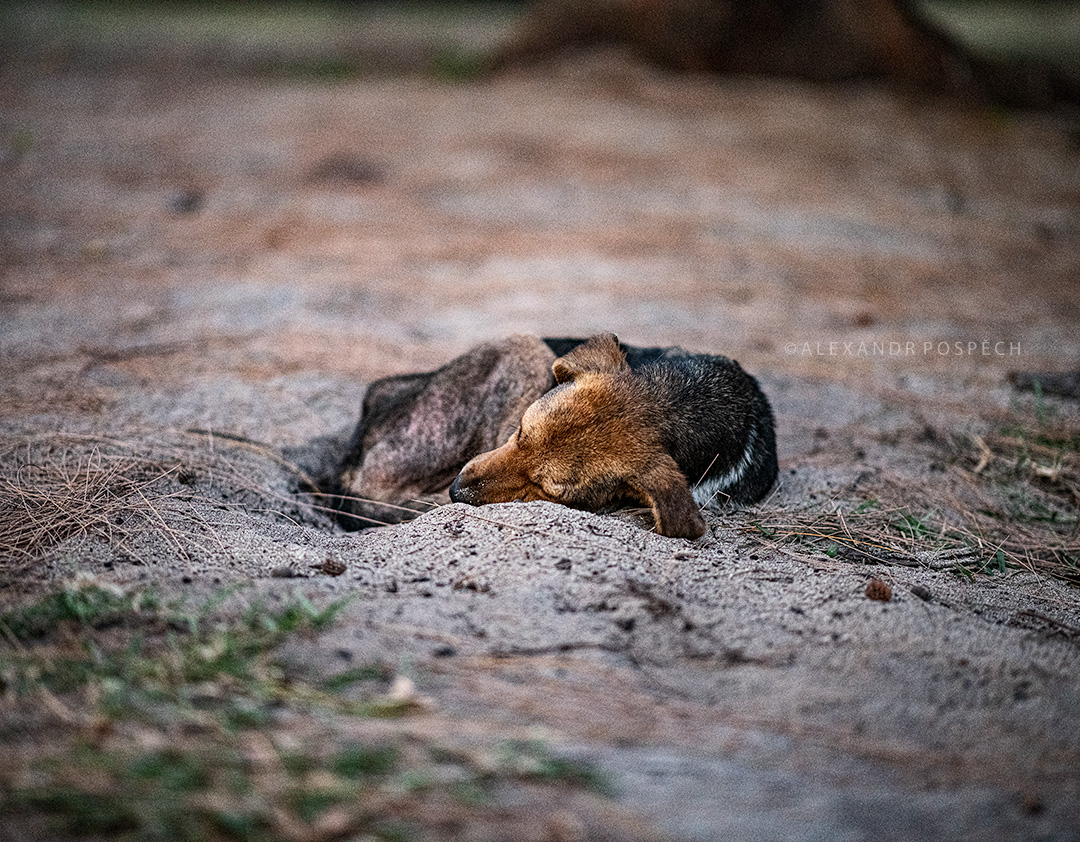The story of Beryl
Meet Beryl, a stray dog we found near the beach in Mauritius during our vacation. This story is about her and her last days.

One day, Beryl’s original owner set out on foot from a nearby village to work. Like a good dog, she followed her master. When he finished his workday, he took a bus back and left Beryl behind.

Beryl was often lying and walking near the road. Maybe she was still waiting for her owner to come for her, as there was a place nearby where she could lay in the shadow without being threatened by passing cars. Skinny and tired, she wasn’t swift to move, but luckily many drivers slowed down when they saw her on the road.

Beryl got mange. Unfortunately, this is a common skin disease among stray dogs. Mange is caused by parasitic mites that trigger itching. When the dog scratches itself, the skin becomes irritated and damaged. While mange looks scary, this disease is relatively easy to cure with proper care. But, when you encounter a stray dog that looks sick, common sense should naturally apply.

Once we found this poor thing, we came every day, bringing her dog food. As she was rather small, it was important to make a reasonable estimate of how much she could eat, as the food went bad quickly in the hot weather and was soon crawling with ants. Half of a 400g can of dogfood was usually sufficient.

What I didn’t realize early on was that stray dogs in hot places could have trouble with access to freshwater, especially when they live close to the beach and sea. The first time my fiancée gave her water, she drank and drank. To be tidier and not leave plastic behind, we bought her a bowl for food and water that we used repeatedly.

During our first encounters, Beryl was afraid and kept her distance. While eating, she continued to check what we were doing. The fifth time we fed her and waited until she finished everything, she noticed us leaving. This time Beryl immediately turned around and went with us. By repeatedly coming to feed her, we gained her trust, and now she was ready to come with us. I was surprised to see that she followed me. I talked to her, called her to come and eat, and took photos, but it was always my fiancée who put the food in her bowl. We didn’t have the option of taking her in, so sadly we had to leave her, only to come back the next day with more food and water.

Our stay in Mauritius was quickly coming to an end. We knew that providing food for a few days was good, but it was certainly not enough. Beryl also needed a vet and proper treatment that would take weeks. My fiancée started to contact local nonprofit organizations that focused precisely on this type of issue. Initial responses were delayed and not positive, and nobody was able to come and take her. Moreover, the weekend was approaching and along with it the end of their office hours. The only hours available were on Monday morning, just before our departure back to Europe. With the dog sanctuaries on the other side of the island and without a pickup car, cage or the time to arrange these items before departure, it seemed that the situation would have a dire outcome and Beryl would be left behind again.

It was on Sunday afternoon when we found some dog adoption groups on social media and quickly requested to join so we could post our photos and descriptions, hoping someone could help and at least arrange local transport. The groups were full of posts about animals needing adoption. Things did not look good in the beginning. But with the help of PAWS Mauritius, we quickly started to get reactions and shares. We were also advised not to share the precise location right away, as poachers may come to kill the poor animal, and sadly it appears that some of them contacted us.

This was on a Sunday afternoon, but many good people responded promptly. These included local NGOs like Happy Tails Mauritius, Second Chance Animals Rescue, MARS Mauritius, and Well-being of Strays Mauritius. It was very heartwarming to see that people cared and wanted to help.
On Mauritius, like on many other islands, stray dogs, cats, and other animals introduced by people pose a threat to local fauna. The answer of the responsible members of society is to capture them, cure their treatable diseases, sterilize them to keep reducing the numbers of stray animals, and hopefully find them new and caring owners.
In the end, on Monday around noon just before our departure, people from the Happy Tails Sanctuary helped and came to take Beryl. In a cage and afraid of the new environment, she looked even smaller than before, but she was in good hands – they planned to cure and feed her, and they would also sterilize her in the fight to solve the issue of stray dogs.

Back then, we were hopeful that Beryl would find a new responsible owner who she could unconditionally devote all her love to. Sadly, her condition was already too grave, as she had a spreading internal infection caused by worms. Despite the fact that she was treated with antibiotics by experienced specialists, fed and taken care of, she died about a week later. All we were able to do was to show her she was loved, at least during her last days.
I would like to thank everyone who helped and who cares for man’s best friend, the environment and nature. Beryl didn’t have a chance to find her new family, but stories like this happen every day all around the world. Estimates claim that there are about 200,000,000 stray dogs in the world.
What are we going to do about this?
